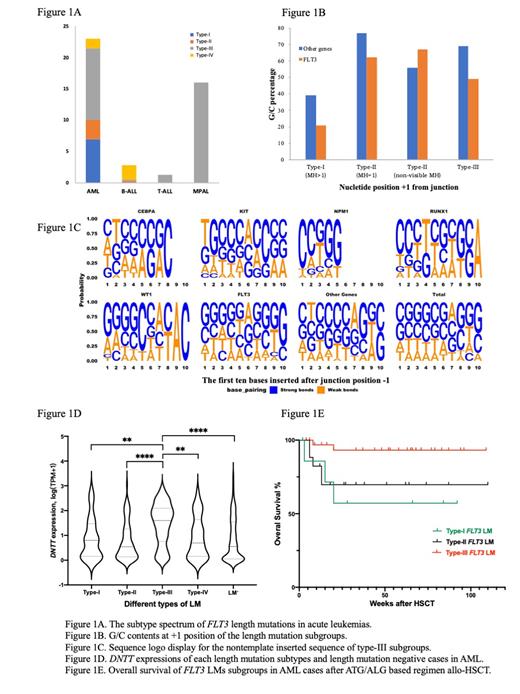Abstract
DNTT encodes the most template-independent DNA polymerases TdT. The canonical function of TdT is to boost the diversity of immunoglobulin and T cell receptors by incorporating non-templated nucleotides (NTN) to their variable regions via RAG1/2 mediated DNA breaks and non-homologous end joining (NHEJ) rearrangement process. This study aimed to investigate the relationship between aberrant DNTT expression and illegitimately TdT-aided microhomology-mediated replication-dependent recombination (MMRDR) with the mutagenesis of gene length mutations (LMs) in acute myeloid leukemia (AML), and their prognosis relevance.
A cohort of 578 AML cases was enrolled. Fifty healthy donors for allogeneic hematopoietic stem cell transplantation (allo-HSCT), 393 B cell acute lymphoblastic leukemia (B-ALL) cases, 78 T-ALL cases, and 25 mixed-phenotype acute leukemia (MPAL) cases were used as control. Next-generation sequencing was performed for mutation analysis of 86 leukemia driver genes. RNA-seq was used to analyze the expression of DNTT and other non-homologous end joining (NHEJ) associated genes. Prognostic was investigated in a subset of 239 AML cases who underwent anti-thymocyte globulin (ATG) or anti-lymphocyte globulin (ALG) based regimen allo-HSCT.
Based on sequence anatomy that considers the MMRDR mechanism and nucleotides characteristics of TdT mediated NTN incorporation, we formulate a classification algorithm for LMs and divide them into four subtypes (type I-IV). Type-I indicates pure duplicated/triplicated germline sequences with identifiable ≥2bp canonical triple microhomology (MH) sequences; type-II indicates pure duplicated/triplicated germline sequences without ≥2bp canonical MH sequences; type-III indicates any LMs with NTN insertions; type-IV indicates any other LMs, mainly deletions.
FLT3-LMs has the highest overall incidence and occur across multiple lineage leukemias. We observed a significant FLT3-LMs subtypes distribution bias among acute leukemia subtypes (Figure 1A). Type-I FLT3 LMs are only observed in AML; there are mainly type-III FLT3 LMs in T-ALL and MPAL; type-II, III, IV FLT3 LMs are predominant in B-ALL. The overall DNTT expression was significantly lower in AML than in other leukemia subtypes and control groups (P < 0.001). This supports that FLT3-LMs subtypes distribution bias might be attributed to the difference in the overall DNTT expression among leukemia lineages.
A total of 458 LMs events were observed in 295 cases (51.0%) within 25 genes (FLT3, NPM1, CEBPA, RUNX1, KIT, etc.) in our AML cohort. The incidence of type-II and type-III LMs, both of which the mutagenesis relies on TdT-aided MMRDR in theoretically speculate, were 31.2 % and 47.8 %, respectively. Type-I and type-II, which manifested as pure germline sequence duplications, account for 43.6% of the FLT3 LMs; type-III LMs, which with additional inserted NTN sequences, account for as high as 50.4% of the FLT3 LMs.
We analyzed the G/C nucleotide contents adjacent to LMs junctions. A significantly high G/C bias was observed at +1 nucleotide position in type-II and type-III subsets (Figure 1B), suggesting that the TdT-aided MMRDR mechanism plays a role in the mutagenesis in these cases. We also observed a strong positive correlation between fragment length and G/C content of the inserted NTN sequences (P < 0.001) within the type-III subset of the 25 LMs genes (Figure 1C), suggesting a higher TdT activity mediates longer inserted sequences.
DNTT expressions level of type-III LMs cases were significantly higher than that of type-I, II, IV LMs cases and cases without LMs in the total 25 LMs genes (Figure 1D) and the FLT3 LMs subset. Similar expression signatures of other NHEJ associated genes RAG2, XRCC4, and XRCC6 were also observed. For the survival analysis in the ATG/ALG based regimen allo-HSCT AML subset, we observed a significantly better overall survival (P = 0.024) in cases positive for type-III FLT3-LMs than that of type-I, II (Figure 1E).
In this study, we proposed a subclassification algorithm for LMs (type I-IV) in AML. Both DNTT gene expression and sequence character suggesting that TdT-aided MMRDR plays a role in the mutagenesis of type-III and type-II LMs. We also observed AML cases with type-III FLT3 LMs benefit more from ATG/ALG based regimen allo-HSCT than cases with other FLT3 LMs types, which may be attributed to the aberrant lymphoid lineage antigen expression.
No relevant conflicts of interest to declare.


